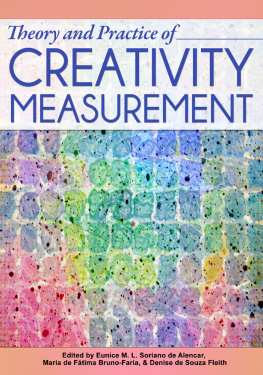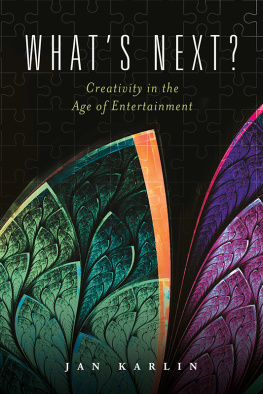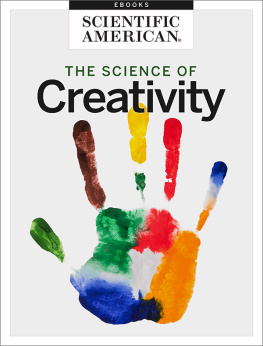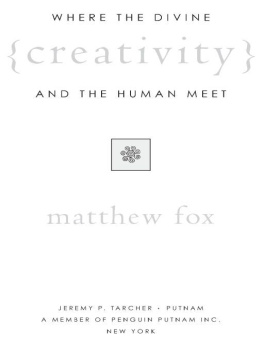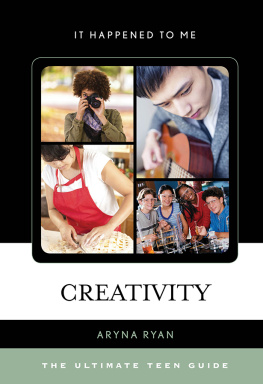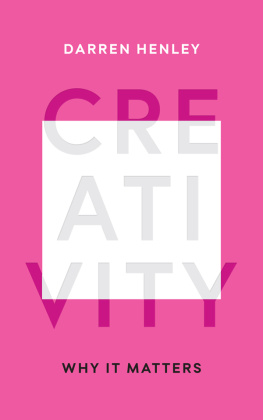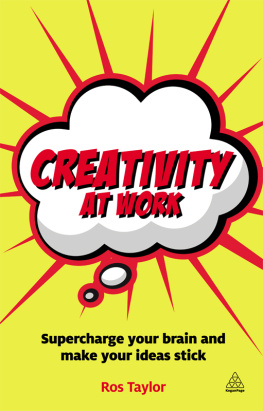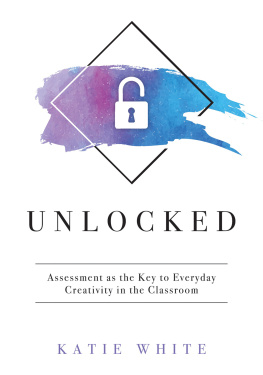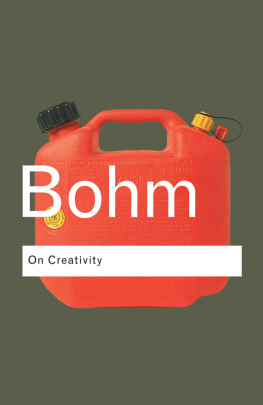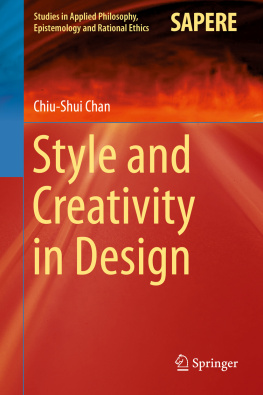Theory and Practice of ______________
CREATIVITY
MEASUREMENT
Theory and Practice of ______________
CREATIVITY
MEASUREMENT
E DITED BY
E UNICE M. L. S ORIANO DE A LENCAR , P H .D.
M ARIA DE F TIMA B RUNO -F ARIA , P H .D.
D ENISE DE S OUZA F LEITH , P H .D.

Copyright 2014 Prufrock Press Inc.
Edited by Bethany Johnsen
Cover and layout design by Raquel Trevino
ISBN-13: 978-1-61821-235-1
No part of this book may be reproduced, translated, stored in a retrieval system, or transmitted, in any form or by any means, electronic, mechanical, photocopying, microfilming, recording, or otherwise, without written permission from the publisher.
At the time of this books publication, all facts and figures cited are the most current available. All telephone numbers, addresses, and website URLs are accurate and active. All publications, organizations, websites, and other resources exist as described in the book, and all have been verified. The authors and Prufrock Press Inc. make no warranty or guarantee concerning the information and materials given out by organizations or content found at websites, and we are not responsible for any changes that occur after this books publication. If you find an error, please contact Prufrock Press Inc.
 | Prufrock Press Inc. P.O. Box 8813 Waco, TX 76714-8813 Phone: (800) 998-2208 Fax: (800) 240-0333 http://www.prufrock.com |
Table of Contents
Eunice M. L. Soriano de Alencar, Maria de Ftima Bruno-Faria, and Denise de Souza Fleith
Eunice M. L. Soriano de Alencar, Denise de Souza Fleith, and Maria de Ftima Bruno-Faria
Eunice M. L. Soriano de Alencar
Denise de Souza Fleith
Eunice M. L. Soriano de Alencar and Denise de Souza Fleith
Cleyton Hrcules Gontijo de Souza and Denise de Souza Fleith
Maria de Ftima Bruno-Faria
Melissa Machado de Moraes and Suzana Maria Valle Lima
Introduction
W e are pleased to offer readers a new book in the area of creativity that focuses on an issue that is attracting and challenging the scholars of this phenomenon: its measurement or assessment. The main factor that mobilized us to organize the book was the growing demand for permission, by professionals from several areas, to use instruments developed by us that we have cited in our publications. (The appendices to this book print our instruments in full for the readers use.) A second factor was the perception of a scarcity of publications in Brazil addressing the measurement of creativity. Although excellent texts related to creativity are already available in the country, offering a rich source of information about different elements that are associated with the expression of creativity in different contexts, the question of its measure has not been discussed extensively enough in the literature available in several countries.
presents an overview of different categories of measures, such as the main tests of creative thinking, instruments to identify interests, personality traits, cognitive styles that are associated with creativity, procedures for assessing the degree of creativity of a product, and alternate ways to identify the level of an individuals creative abilities. It also addresses some parameters to be considered when evaluating the quality of the available instruments, as well as the steps to be taken in their application and interpretation.
.
Because of the importance that has to be given to education, especially in Brazil, where few have access to higher education, turning attention to creativity in the classroom becomes a key issue. Thus, in .
Continuing the focus on education, .
Returning to a more specific aspect of education, presents a test of creativity in mathematics. Because it is a discipline in which students often have difficulties, this measure can help identify gaps to be minimized in the teaching of mathematics, so that this discipline can be a fertile space for the expression of creativity.
The final two chapters focus on specific measures in the organizational context. The Indicators of Climate for Creativity (ICC), which is an instrument that identifies a set of incentives and barriers to creativity in the workplace, is described in . When aware of the strategies used by professionals at work, managers can trace strategic actions that facilitate the expression of creativity.
It is noteworthy that, in addition to describing the process of construction and validation of instruments, we present these instruments in their entirety. This makes it possible for interested professionals to use the different measures in their research or in their work practice, contributing not only to the advancement of knowledge about different aspects of creativity, but also to its flourishing in diverse environments.
Eunice M. L. Soriano de Alencar
Maria de Ftima Bruno-Faria
Denise de Souza Fleith
Chapter 1
The Measurement of Creativity
Possibilities & Challenges
Eunice M. L. Soriano de Alencar, Denise de Souza Fleith, and Maria de Ftima Bruno-Faria
T he primary objective of this chapter is to discuss key aspects related to measures of creativity. It initially gives a brief history of studies of this construct, pointing out factors that prompted interest in its investigation, besides highlighting recent theoretical contributions and benefits of the development and use of procedures to measure various facets of creativity. Some main measurement instruments that have already been developed are listed in the text. The chapter also describes technical issues to be considered by those interested in making better use of the available assessment instruments of creativity, signaling their limits, possibilities, and also the precautions that should be taken in both the application and interpretation of their results. Its expected to be a source of inspiration for researchers in the area, unveiling new possibilities for research and for the promotion of conditions conducive to the development and expression of creative potential.
As widely reported in previous texts (Alencar, 2007; Alencar & Fleith, 2003b; Cropley, 2006; Nakano & Wechsler, 2007; Oliver, Shah, McGoldrick, & Edwards, 2006; Smith-Bingham, 2006), the importance of creativity in diverse contexts has been increasingly recognized, given its benefit not only for the individual but for society as well. As pointed out by Smith-Bingham (2006):
The future prosperity of developed and developing countries will increasingly depend on their capacity to innovate, to develop ideas into new products and services, to develop new technologies and new forms of production, to introduce products and services to new markets (p. 11).
Brief History of Studies on Creativity
The interest of psychology in the study of creativity and the conditions that favor its expression is relatively recent. This interest had its most significant starting point in the 1950s, as the result of several factors, such as the influence of the humanist movement. Rogers (1959) and Maslow (1959), for example, pointed to the human potential for self-actualization, describing the conditions that facilitate the expression of creativity, besides drawing attention to mental health as a source of creative impulses. Moreover, they conceived creativity as the result of a mutually beneficial interaction between the person and the environment. Rogers also considered autonomy and the resistance to excessive social control as necessary conditions for creative activity. Rogers signaled the role of society, allowing the person freedom of choice and action, as well as recognizing and encouraging the individuals potential to create.
Next page
